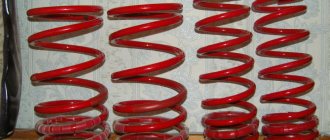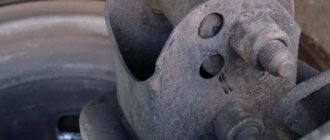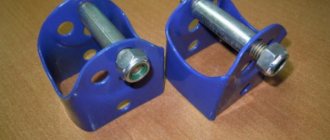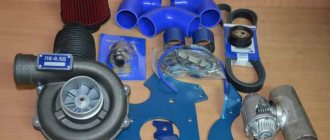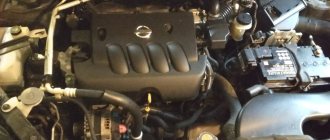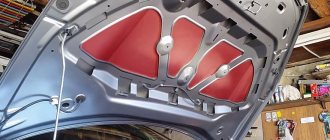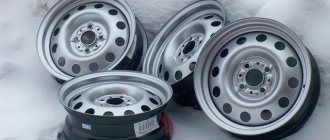In Russia, conditions for operating a car are not the easiest, few would argue with this. At the same time, most car models driving on our roads are not suitable for these same roads, primarily due to their low ground clearance.
From this article you will learn:
- What is ground clearance (ground clearance)
- The most inexpensive way to lift a car
- We increase ground clearance with spacers in the suspension
- We increase ground clearance by replacing the suspension
- Air suspension
- What does increasing ground clearance mean?
Many owners of such cars (Ford, Kia, Chevrolet, Nissan, Hyundai, Toyota) are wondering about increasing the ground clearance of their car. How possible is this and how can it be made easier?
What is ground clearance (ground clearance)
To begin with, it is worth saying that many drivers confuse the concept of ground clearance (ground clearance) and the distance from the thresholds of the car to the road surface. Ground clearance is the distance from the lowest point on the bottom of the car to the road surface. This point is not necessarily the thresholds of the car.
For most cars, the lowest point on the bottom is located at the front; this can be the front suspension elements or the engine sump (if equipped) and the gearbox. Occasionally, the lowest point may be a gearbox on the front or rear axle, or rear suspension elements.
There are different ways to increase the ground clearance of a car, some of them are very simple and not expensive for the driver, but there are also those that will require serious intervention in the car’s suspension and significant expenses. Let's consider these methods in order of increasing labor costs and cost for the driver.
It should also be noted that any method of increasing the car’s ground clearance has a number of significant disadvantages that must be taken into account before deciding to lift the car.
Installing spacers on rear struts for springs
Putting rear spacers under the springs is a dubious task. It is much easier to install adapters in the form of a steel bracket under the lower mount of the rack (house).
But if you really need to tighten the spring, you will have to remove and disassemble the entire rack:
- while the spring is compressed under the weight of the machine, screw ties are installed on its coils, and the rod is weakened as much as possible;
- the upper and lower fastenings of the rack are disconnected, after which it is removed from under the body;
- the rod nut is unscrewed, the upper support with the cushion is removed;
- a spacer is installed under the pillow;
- assembly operations are performed in reverse order;
- Most often, problems arise with corrosion and souring of fasteners, so you need to stock up on penetrating liquid and a gas burner.
After any change in vehicle clearance, all suspension angles must be adjusted. In the case of the rear, this can not be done on all cars; you will have to put up with some deterioration in handling, a tendency to skid and increased tire consumption.
The usual speed on highways will have to be reduced significantly, since the car may suddenly and at unpredictable speeds lose stability.
The most inexpensive way to lift a car
One of the easiest ways to lift your car is to install slightly larger tires than stock.
For example, instead of standard 195/60R15 tires, we install 195/65R15 tires. In the marking of this tire size, the tire profile (its height) is specified as a percentage of the width (195 mm) and is the following values:
- Tires size 195/60/R15 have a height of 117mm (60% of 195mm);
- 195/65 tires have a height of 126.7 mm (65% of 195 mm);
Here the difference in the height of these two tires is 1 cm, that is, by simply changing the size of the tires you can raise your car by 1-2 cm. If you experiment with the selection of not only tires, but also wheels, then you can add 1-2 more to the standard ground clearance cm.
Disadvantages: Installing larger non-standard tires on a car entails not only an increase in ground clearance, but also a number of disadvantages:
- The car will become more reluctant to accelerate (the diameter of the wheel becomes larger, it is more difficult for the engine to spin the wheel);
- Fuel consumption may increase noticeably (it is more difficult for the engine to spin larger wheels, the more dynamic the ride with such wheels, the more noticeable is the excess fuel consumption);
- The speedometer will show a speed lower than it actually is (the speedometer sensor reads the speed of the wheel; with a larger wheel diameter, the car travels a longer distance than the one the speedometer is set to);
- The car's odometer will show less mileage (the odometer sensor counts the number of wheel revolutions, with a larger diameter the car will travel a longer distance)
It also needs to be said that you shouldn’t get too carried away and choose tires several sizes larger than the standard ones at once, since wheels that are too large can harm the car itself. For example, they may begin to rub against the wheel arches on uneven roads or cling to the front fenders when cornering, not to mention the increased load on the car’s suspension. At most, you should take wheels 1-2 “sizes” larger than the standard ones.
This method is the most optimal if the car owner needs to lift the car temporarily, for example, only for the winter. Then in the summer, having installed standard-sized tires, the car owner again returns the car to its standard parameters.
Adjustable air suspension
The most expensive way to not only increase ground clearance, but also adjust it depending on road conditions and driving style, is to completely replace the standard suspension with a pneumatic system. Until recently, only luxury cars were equipped with such devices. Currently, a wide variety of vehicles (even so-called budget vehicles) can be equipped with air suspension. A fully ready-to-install kit usually consists of:
- two front struts (assembled);
- two rear shock absorbers;
- compressor;
- receiver;
- pressure gauge (or several depending on the type);
- valve block;
- control keys;
- dehumidifier;
- pneumatic line tubes;
- connecting fittings;
- bypass valves;
- installation wires and necessary fasteners.
The main “working” elastic element in the air suspension is compressed air. Hence all the ensuing advantages (compared to traditional types). This is first of all:
- increasing the smoothness of the ride, and as a result, the comfort of movement;
- the ability to adjust the ride height (including automatic, if a special controller is installed);
- significant reduction in driving noise.
The only disadvantage of such an upgrade, in our opinion, is the high cost of both the kit itself and the work required to install it (if you do not have sufficient skills to carry out the installation yourself).
For information! A completely ready-to-install air suspension kit (for front-wheel drive VAZ cars) today costs about 53,000÷55,000 rubles. You will have to spend another 20,000÷30,000 rubles to install such a device at a service station.
We increase ground clearance with spacers in the suspension
Spacers to increase ground clearance are one of the most popular ways to raise your car. This method is relatively inexpensive, but it already requires intervention in the car’s suspension, which requires some skills (if you don’t have them, it’s better to trust a car service).
There are two types of spacers:
- Spacers that are inserted into the spring itself and do not allow 1-2 turns of the spring to compress are called “interturn”
- Spacers, which are installed under the cups of the suspension struts and allow you to raise the entire body of the car above its suspension (and above the road)
The cost of interturn spacers is relatively low and their installation does not take much time (car owners with repair experience are even quite capable of performing this procedure on their own). Interturn spacers are made of plastic, aluminum and polyurethane.
Disadvantages: Due to the restriction of the spring coils, the car's suspension becomes much stiffer, the shock absorber stroke length increases, and the car's handling may deteriorate (the price to pay for the increased ground clearance). Also, the coils of springs in places of contact with spacers may experience increased load, which is why there is a risk of their breakage. After the procedure, it is necessary to set the correct toe-in angles.
The big advantage of installing interturn spacers is that their cost is relatively low and installation is quite simple. The car owner can install them, as they say, “for testing” in order to experience for himself what it’s like to drive a car with increased ground clearance. If he doesn’t like the behavior of the car, he can remove them at any time.
For example, interturn spacers from a German manufacturer can be ordered at a discount here >>>
Spacers from another German brand that produces its products in Russia can be ordered here >>>
As for the spacers installed under the suspension cup of the car, they already imply a fairly large amount of work with the suspension. To install them, each rack must be dismantled and installed back, together with the spacer. Such work requires the presence of a lift, so it is best to install such spacers in a car service center.
Increasing ground clearance using spacers under the suspension strut cup is one of the most inexpensive, but at the same time optimal ways to raise a car, since the car’s suspension will work as normal, and the entire body will be raised a few centimeters above the suspension (and above the road) . However, this method is not without its drawbacks.
Disadvantages: Raising the car body above the suspension shifts the overall center of gravity of the car upward, which, under unfavorable circumstances, can lead to a serious rollover accident. With the ground clearance increased in this way, the driver should not heavily load the roof rack of the car, as well as test the limits of the car's capabilities by driving fast and aggressively. After the procedure, it is necessary to set the correct toe-in angles.
Instructions for installing front spacers to increase ground clearance
A detailed procedure for installing spacers is contained in the instructions included with the kit, since it greatly depends on the specific vehicle.
The design of the upper strut mounts can vary greatly, as can the features of the spacers. But there are also general points:
- many spacers do not require not only removing the spring from the strut, but also dismantling the strut altogether;
- in this case, unscrew the nuts of the studs securing the upper swivel support to the body glass with the car standing on its wheels;
- after lifting the car with a jack and installing it on a stand, the wheel is removed and a spacer is mounted on the upper part of the support;
- the studs are inserted into the standard holes of the glass and secured with nuts;
- the wheel is put in place and the car is removed from the jack;
- If difficulties arise, it may be necessary to either release the strut from the lower ball joint, outer CV joint, tie rod end, ABS sensor cable, brake caliper, or pre-compress the spring using a set of zip ties.
When unscrewing the shock absorber rod nut, you must be careful, making sure that the spring is compressed and there is no load on the nut.
We increase ground clearance by replacing the suspension
A noticeably more expensive way to lift a car is to replace the suspension springs. To make the car taller, you need to choose stiffer springs than standard ones, or longer ones. The stiffness of the springs is indicated in their markings, as well as their length.
When replacing springs, it is necessary to ensure the correct operation of the shock absorbers, which requires special devices that lengthen their attachment points, or replace the shock absorbers with longer ones. Standard shock absorbers will not be able to work properly with the car body raised above the road and will quickly fail.
Disadvantages: Installing non-standard springs and shock absorbers forces the car’s suspension to operate in maximum permissible modes, or even in conditions not intended for safe movement. After the procedure, it is necessary to set the correct toe-in angles.
Video
Main author of the site and founder of several automotive Internet projects
On the vast majority of modern cars, especially foreign-made ones, the body height above the ground lies in the range of 130–160 mm. This is done for the sake of the car’s controllability, its stability and driver comfort. But the low landing is also a problem when driving on Russian roads with poor-quality surfaces, where the engine sump tends to catch on some bump. A motorist can solve this issue independently by taking measures to raise the car 3–5 cm above the road. Technically speaking, you need to increase the ground clearance yourself.
What does increasing ground clearance mean?
Every car owner planning to increase the ground clearance of their car needs to understand that changing the ground clearance is an intervention in the design of the car, which entails serious consequences.
Increased ground clearance changes the car’s center of gravity and parameters set at the manufacturer’s factory that directly affect traffic safety, such as cornering stability and vehicle handling (not to mention a decrease in driving comfort).
No one can guarantee safe driving in a car with increased ground clearance, and in the event of an accident and litigation, interference with the car’s design may become a circumstance that will play against its driver. However, most drivers who decide to increase the ground clearance of their car are fully aware of these risks and consciously take them.
To avoid all possible risks associated with tampering with the design of the car, it is best not to get involved with increasing the ground clearance, but try to consider purchasing a car with high ground clearance, especially since there are many options for such cars today.
True, we need to make a reservation that you should not believe the characteristics that manufacturers write about their cars, but check everything in practice:
More springs
If you have a leaf spring suspension, which is rare in the modern world, then you can solve your problem by simply adding one or two leaf springs. Most often, such a suspension is used on old SUVs or Gazelle. Among the minuses, it is worth noting a slight increase in rigidity and a change in the center of gravity, but the maximum load on the suspension will become greater, that is, you will be able to load a little more cargo.
If you have an SUV, then most likely you can install other wheels that are significantly larger than the standard ones. But in fact, it will be better to install several new plates, since there are much fewer disadvantages.
